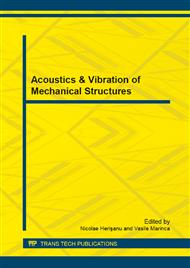p.165
p.170
p.178
p.184
p.191
p.195
p.203
p.208
p.213
Study of a Half Car Suspension Model
Abstract:
In this paper, a model with four degrees of freedom is studied to assess the discomfort of car passengers due to vibrations. The response of the half car model due to road irregularities is presented in order to attain a control method for the dampers. For the analytical study, the differential equations of the motion were written in order to determine the critical frequencies. The resulted model takes into account both the forced and damped solution for a numerical case, thus giving a more detailed overview of the phenomena. Using this numerical case, a control method can be developed to reduce the passenger discomfort, based on the motion diagrams.
Info:
Periodical:
Pages:
191-194
Citation:
Online since:
September 2013
Authors:
Keywords:
Price:
Сopyright:
© 2013 Trans Tech Publications Ltd. All Rights Reserved
Share:
Citation:


